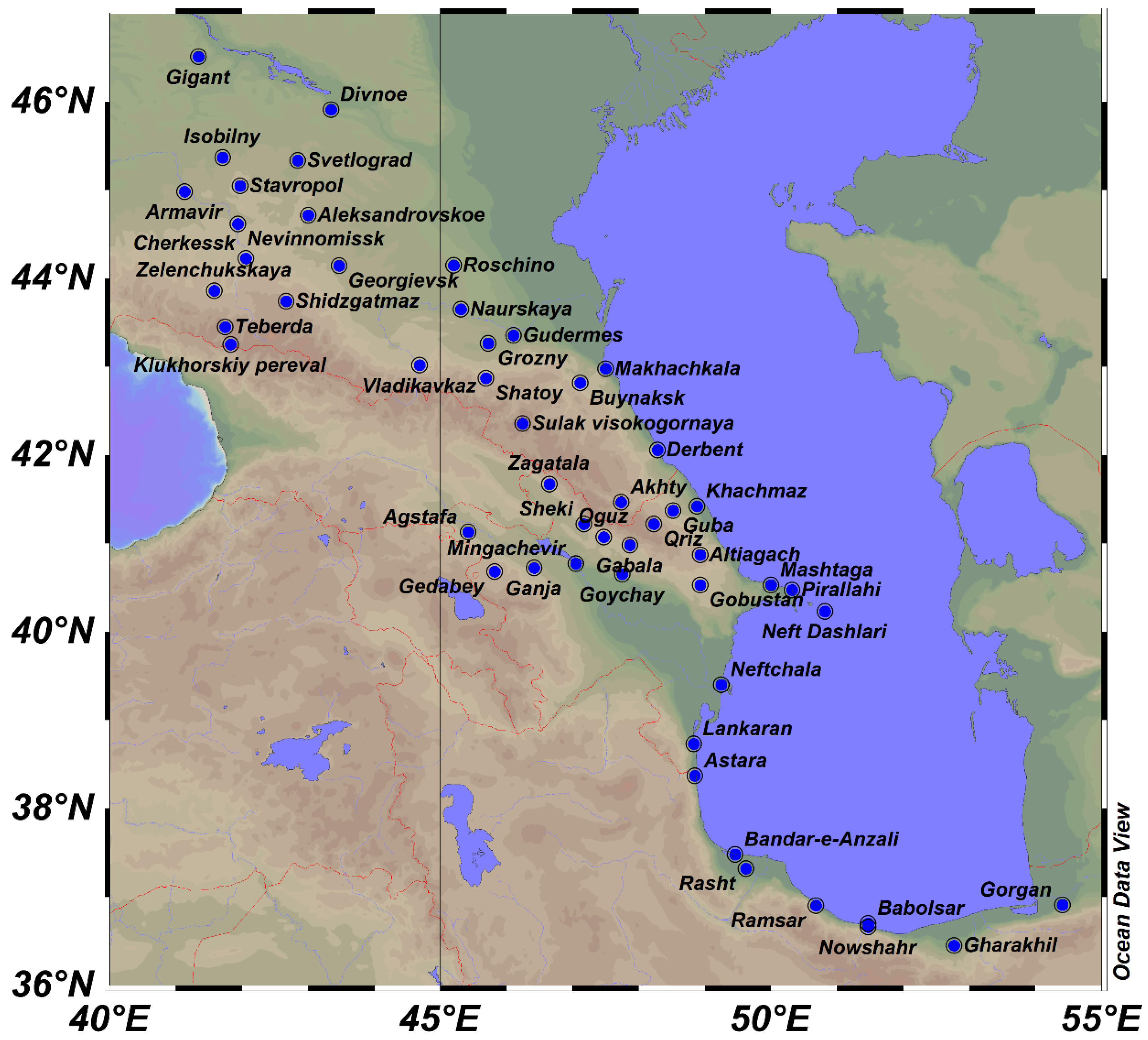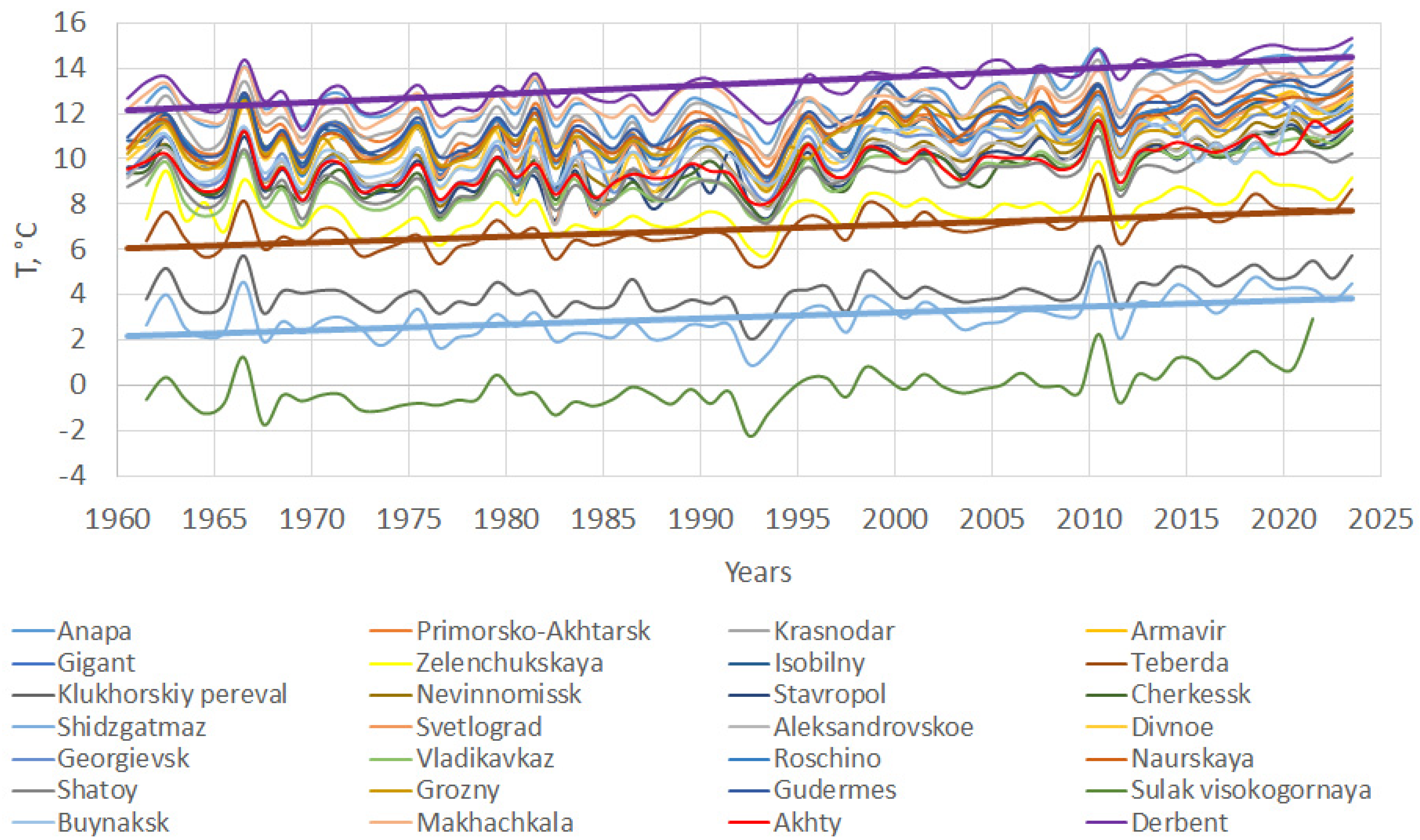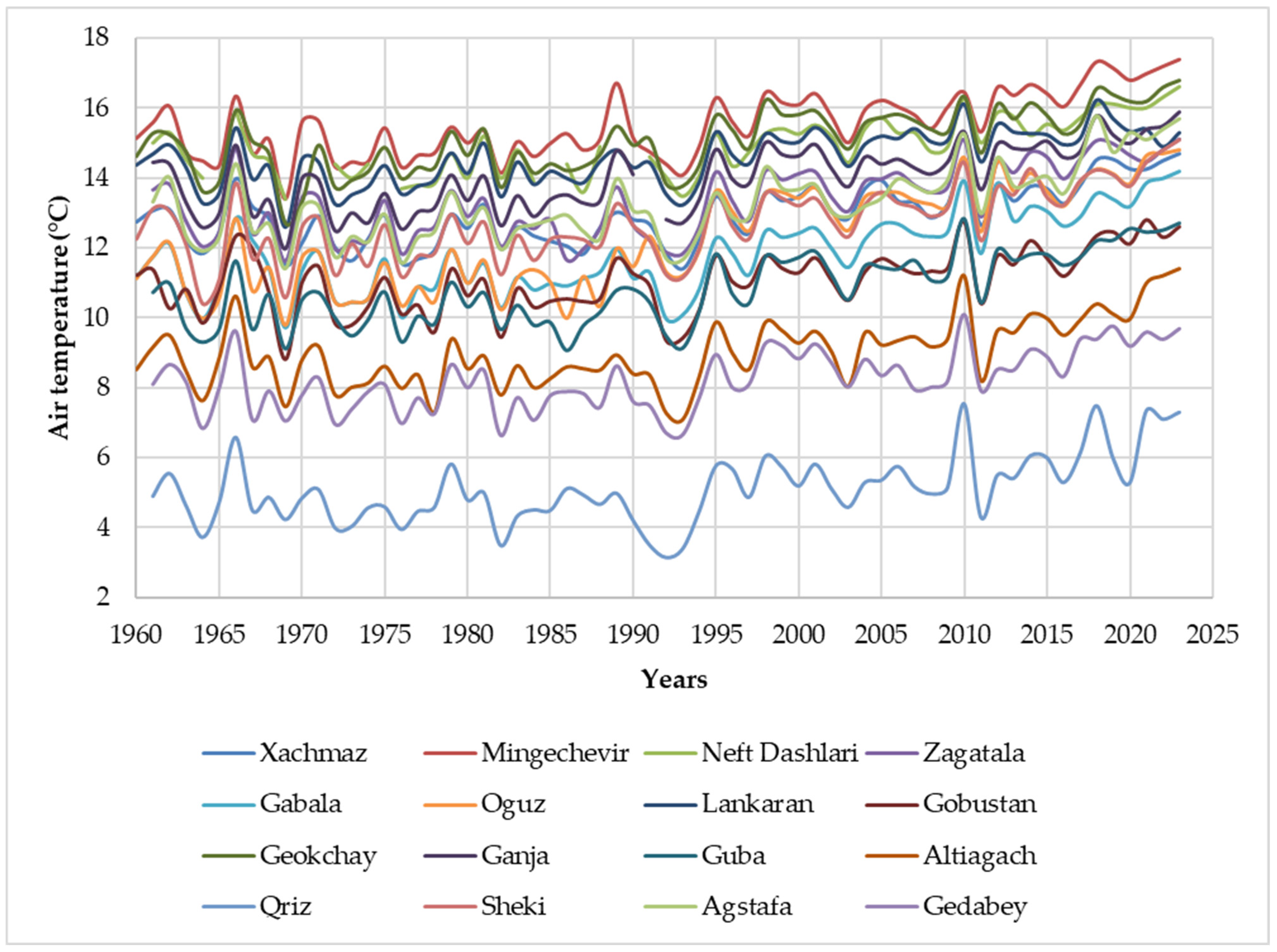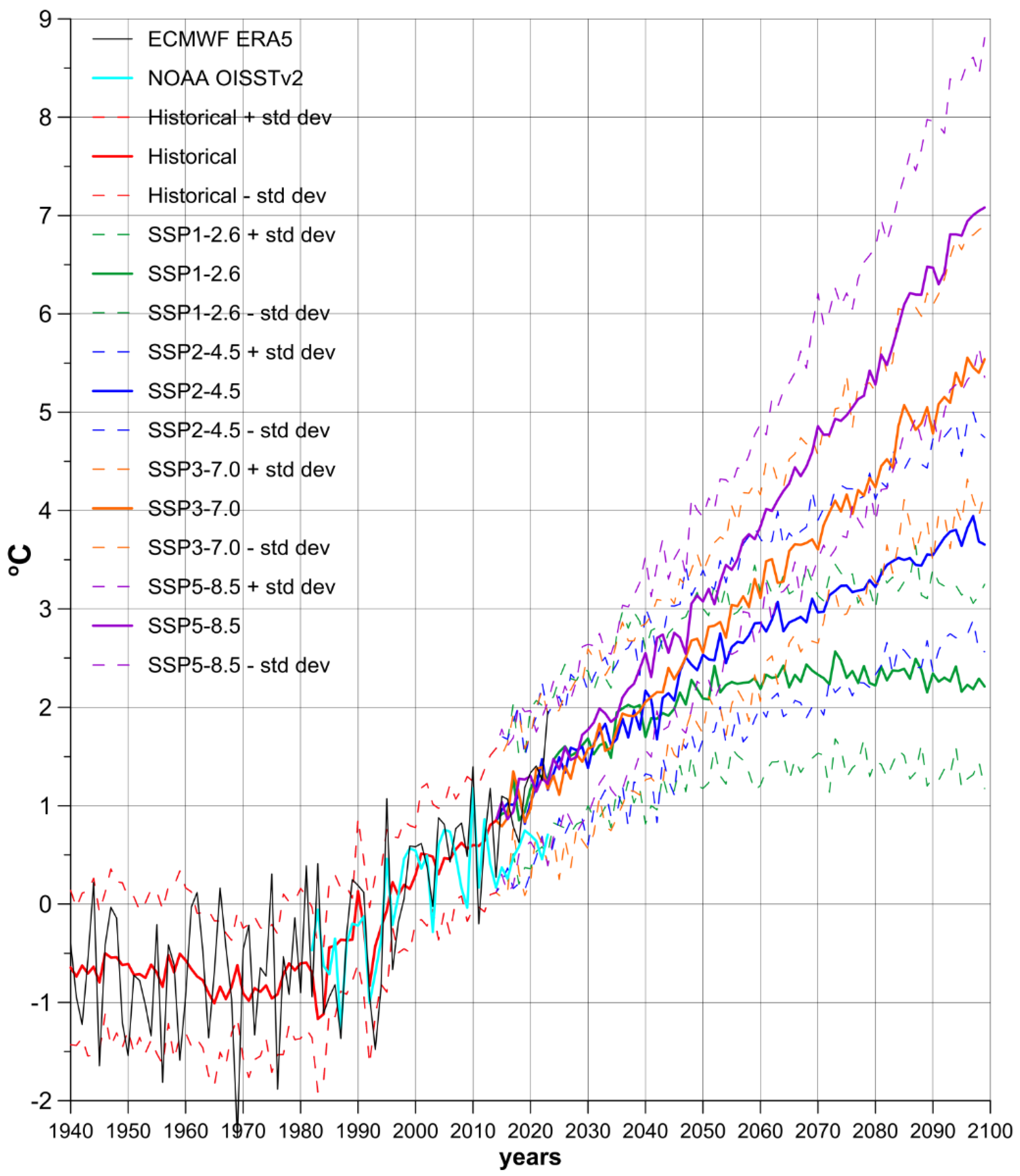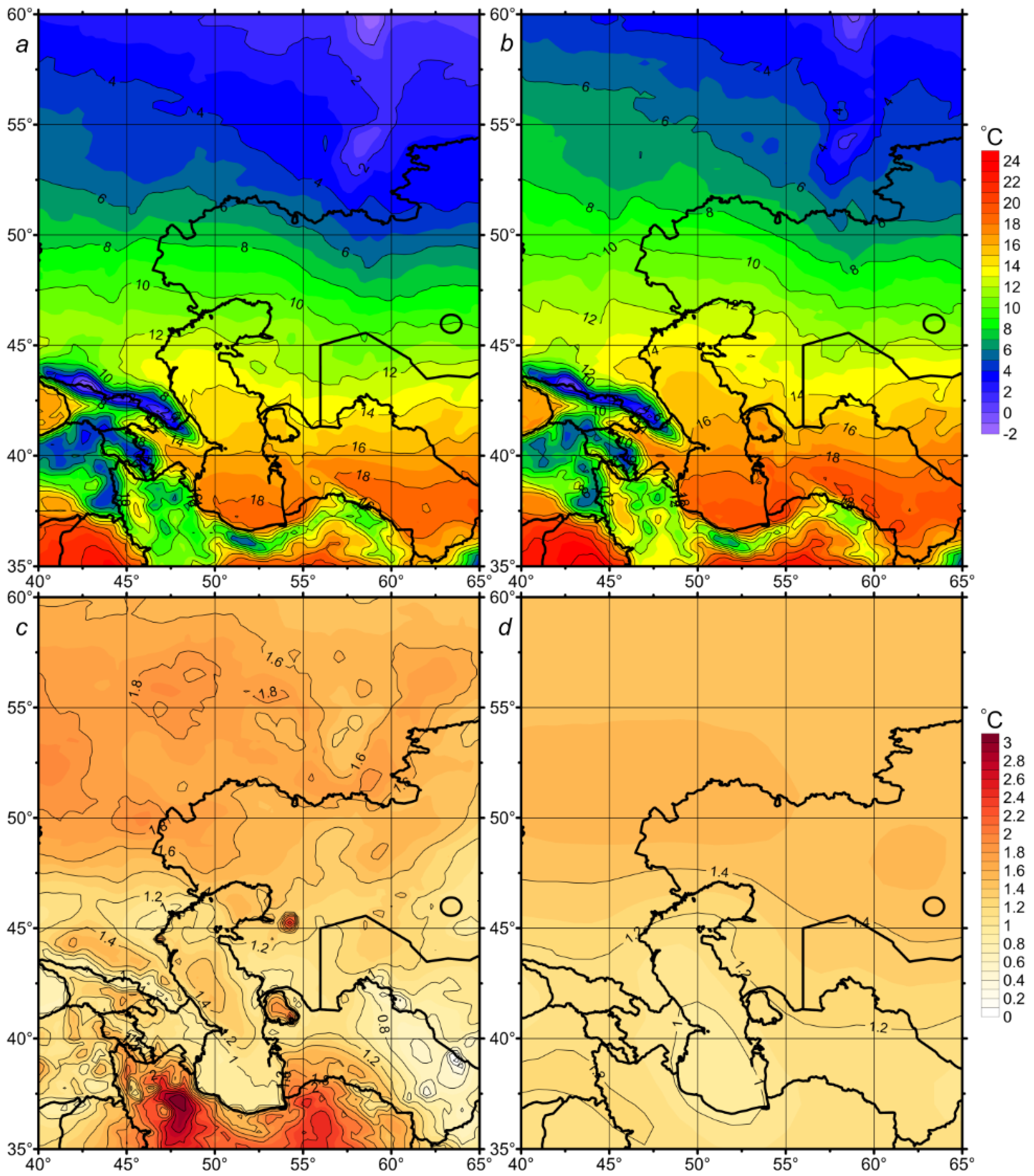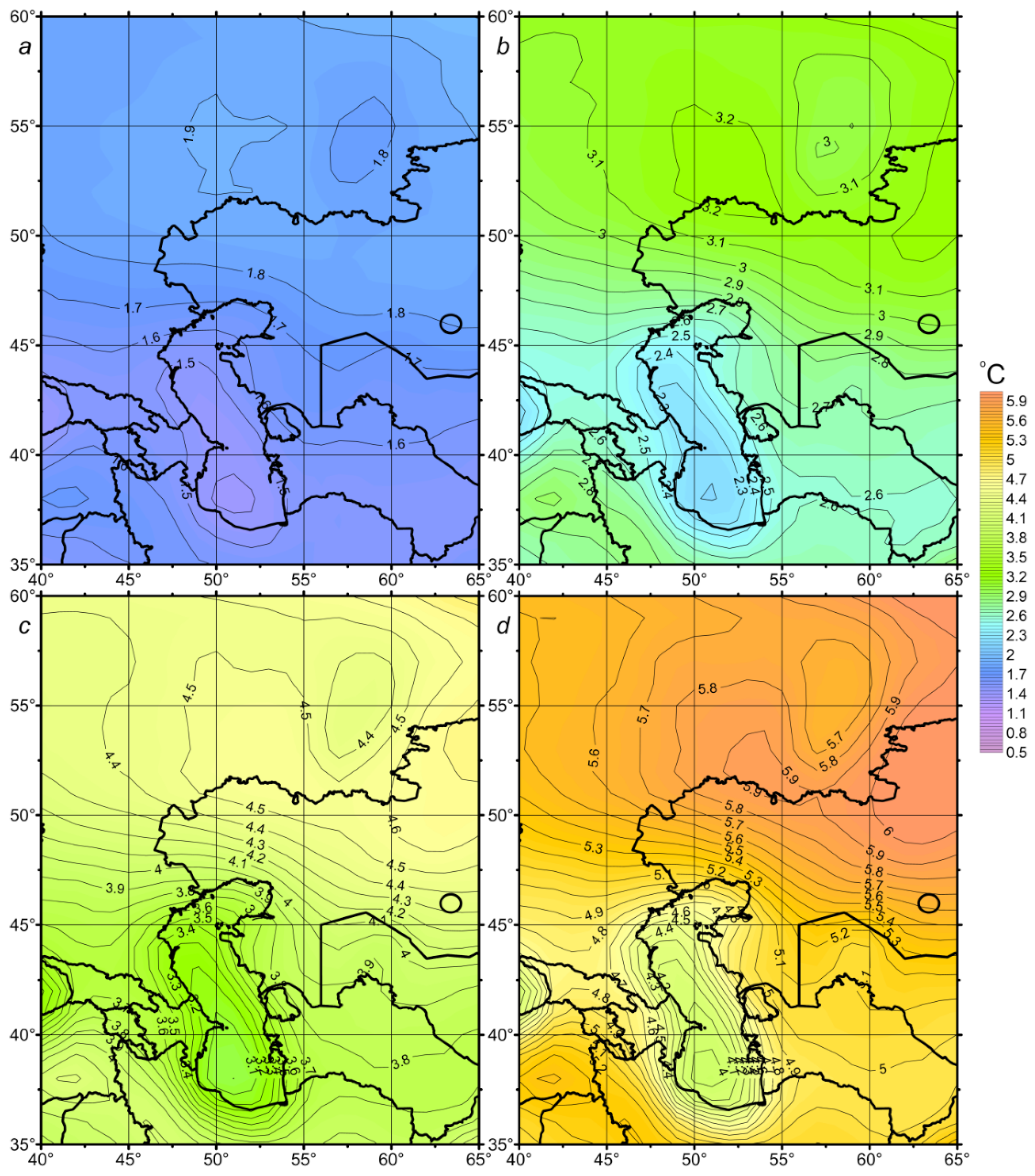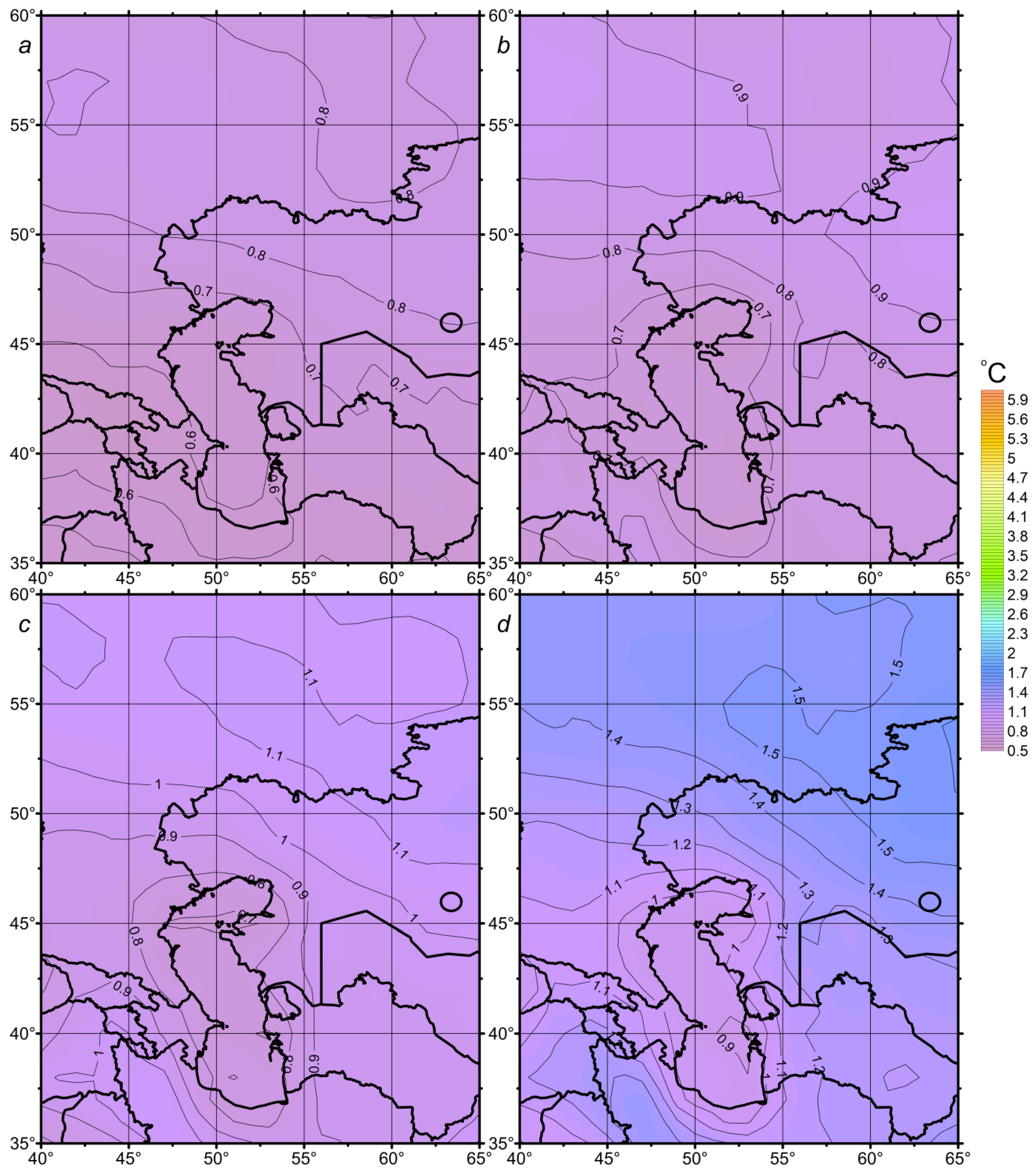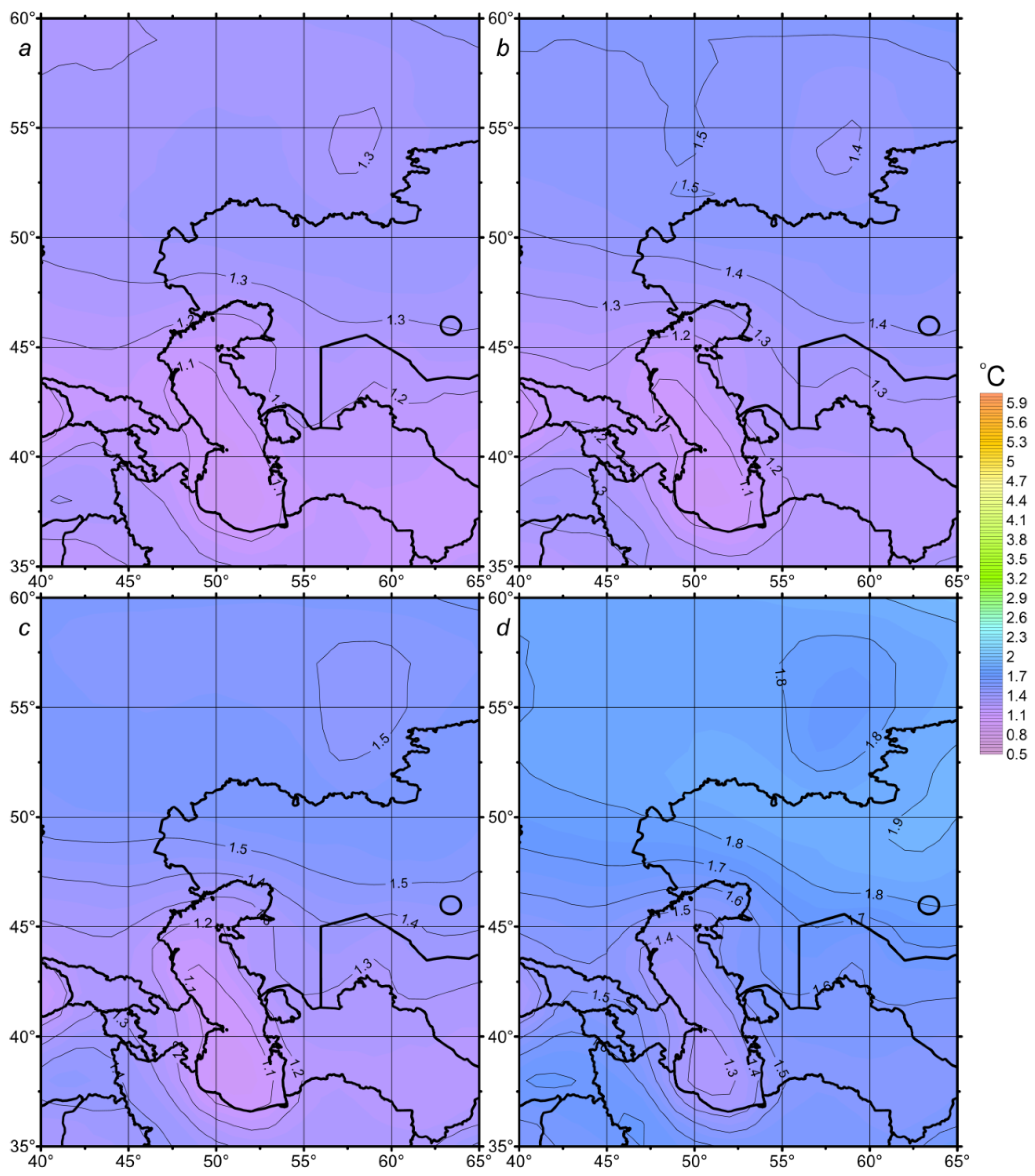3.1. Weather Stations
Results from the analysis of mean NSAT values and their standard deviations, recorded at meteorological stations in the northwestern (0.9 ± 0.2°C), central-western (1.0 ± 0.3°C), southern parts (0.7 ± 0.2°C) of Caspian region, demonstrate a significant increase in average NSAT during the period 2011–2023 compared to 1985–2010 (1986–2010 for the southern part) (
Table 1,
Table 2,
Table 3,
Table 4 and
Table 5). Moreover, interannual NSAT fluctuations show a high degree of coherence across the various meteorological stations analyzed (
Figure 2 and
Figure 3). An increase in the average annual NSAT was noted for all the meteorological stations considered in the northwestern Caspian region (Russia) (
Figure 2). For all stations, the increase in NSAT and linear trends were statistically significant at the 0.05 level. The course of change in the average annual NSAT is mainly synchronous for the meteorological stations considered (
Figure 2). The values of Pearson’s correlation coefficients between the average annual NSAT at separate weather stations for the period 1960–2023 were significant (r > 0.9).
The Republic of Azerbaijan, in the central Caspian region, is characterized by complex terrain. Data from 19 hydrometeorological stations across the region show that, from 1991 to 2018 compared to the 1961–1990 climate normal, the average annual NSAT increased by 0.83 °C, ranging from 0.61 to 1.17 °C, with a spatial standard deviation of ±0.15 °C. The increase in NSAT was slightly lower (0.61–0.65 °C) for the offshore stations of Neft, Dashlari, and Chilov [
31,
32]. An increase in average annual NSAT was observed at all meteorological stations within Azerbaijan (
Figure 3). For all stations, both the NSAT increase and the linear trends (
Figure 2) were statistically significant at the 0.05 level. The annual NSAT changes generally exhibited a synchronous pattern across the analyzed meteorological stations (
Figure 3).
Table 2 presents the geographic coordinates and primary temperature data for the Azerbaijani meteorological stations included in this study. From 1960 to 2023, average annual NSAT ranged from 3.1 to 17.4 °C across the various stations, with interannual standard deviations of 0.7–1.4 °C.
A comparison of the 1985–2010 and 2011–2023 periods indicates a marked rise in average annual NSAT in the most recent years. The average NSAT increase, as shown in
Table 2, is 1.0 °C, with individual station increases varying between 0.8 and 1.5 °C. The spatial standard deviation of the temperature increase is 0.3 °C. This analysis aligns well with results from the stations situated within the northern part of the Caspian Sea basin (
Table 1).
Validating the CMIP6 model experiments against weather station temperature data is of considerable importance. For this reason, average NSAT values were calculated for the periods 1940–1969 and 1994–2023, along with their differences, to facilitate comparison with the results of the CMIP6 historical experiment (
Table 3).
Table 3 reveals an average temperature increase of 1.37 °C across all weather stations between 1940–1969 and 1994–2023, with a spatial standard deviation of 0.29 °C. As discussed in subsequent sections, these observations are consistent with the findings obtained from the 33 CMIP6 ESM ensemble.
As shown in
Table 4 and
Table 5, an increase in average NSAT is seen at all stations in the southern part of Caspian region (Iran) in the period 2005–2023 compared to the period 1986–2004 by 0.8 ± 0.1 °C on average. It should be pointed out that observation data for the southern part of the Caspian Sea is available for the period of 1986–2023; thus,
Table 4 and
Table 5 were prepared based on the available data.
3.3. CMIP6 Models
The average NSAT of the Caspian region from the historical experiment of the 33 CMIP6 ESM ensemble (
Figure 4, red line) exhibits interdecadal variations similar to ERA5. The ESM ensemble captures the small NSAT changes from the 1940s to the mid-1980s and the substantial NSAT increase from the mid-1980s to the present. Individual ESMs do not always accurately reproduce the natural modes of climate variability, and averaging across the ensemble suppresses this natural climate variability. This is evident in the weak interannual fluctuations of the average NSAT for the multi-model ensemble (
Figure 4, red line).
Table 7 (Column 3) presents the changes in the average NSAT of the Caspian region between the 30-year periods of 1940–1969 and 1994–2023 for each of the 33 CMIP6 ESMs from the historical and SSP2-4.5 experiments, along with their minimum, maximum, average, and standard deviation values. Any SSP experiment could have been selected instead of SSP2-4.5, as their results are nearly identical for 2015–2023. From 1940–1969 to 1994–2023, the average NSAT increase in the study region was 1.31 °C according to the 33 CMIP6 ESM ensemble, with a standard deviation of 0.48 °C (
Table 7), consistent with ERA5 data. Notably, the interannual variability of NSAT anomalies from the ERA5 reanalysis falls almost entirely within the intermodel spread of the 33 CMIP6 ESM ensemble (
Figure 4, dashed lines). Furthermore, all 33 ESMs reproduce the increase in average NSAT in the study region between 1940–1969 and 1994–2023.
Some of the considerable interannual NSAT variability observed by ERA5 in the Caspian region (
Figure 4, black line) may be linked to modes of natural climate variability like the El Niño–Southern Oscillation (ENSO) and the NAO [
33]. This is supported by the fact that ensemble averaging suppresses this natural climate variability, although it is present in individual ESM results, evidenced by the significant standard deviation (averaging 0.5°C) of NSAT anomalies across the ESM ensemble. Weather station data, ERA5, OISSTv2, and the 33 CMIP6 ESM ensemble average of the historical experiment results all show significant cooling in 1992–1993 (
Figure 2,
Figure 3 and
Figure 4). Since the multi-model NSAT averages suppress natural climate variability but retain the influence of external forcing, the local temperature minimum of 1992–1993 can be attributed to the 1991 eruption of Mount Pinatubo, which released large amounts of aerosols into the atmosphere, reducing incoming solar radiation. The multi-model NSAT averages (
Figure 4, red line) and weather station data from the Caspian Sea region (
Figure 2 and
Figure 3) also exhibit NSAT decreases lasting several years in the 1960s and 1980s, likely caused by the eruptions of the Agung (1963) and El Chichón (1982) volcanoes. However, the ERA5 NSAT time series (
Figure 4, black line) does not clearly show these minima, possibly due to the superposition of antiphase interannual variability, which is suppressed in the multi-model ensemble but present in weather station data and reanalyses.
The results show that interdecadal changes in average NSAT time series from ERA5 and the historical–SSP experiments of the 33 CMIP6 ESM ensemble for 1940–2023 generally agree well, lending confidence to ESMs-based NSAT projections through the end of the 21st century. This agreement is further supported by the similar NSAT increases from 1940–1969 to 1994–2023 based on weather station data and the historical–SSP experiments of the 33 CMIP6 ESM ensemble (
Table 3 and
Table 7).
Figure 4 presents the average values (solid lines) and variability range (dashed lines) of annual NSAT anomalies in the study region for scenarios SSP1-2.6, SSP2-4.5, SSP3-7.0, and SSP5-8.5 from the 33 CMIP6 ESM ensemble for 2015–2099. Variability boundaries were defined as the ensemble average NSAT for a given scenario plus (upper boundary) and minus (lower boundary) one standard deviation of the annual NSAT anomalies from these 33 CMIP6 ESMs. All SSP scenarios examined project a warming trend in NSAT, both when averaged across the ensemble and in individual ESMs. As anticipated, the rate of warming accelerates with increasing CO
2 emissions (
Figure 4,
Table 7). Nevertheless, the projected increase in average NSAT remains relatively consistent across all SSP scenarios until approximately 2040, with a projected increase ranging from 1.24 to 1.67 °C (standard deviations: 0.36–0.46 °C) between the periods 1994–2023 and 2024–2053 (
Table 7). The SSP1-2.6 scenario envisions immediate and substantial reductions in anthropogenic CO
2 emissions, leading to net-zero emissions by 2075, resulting in a stabilization of NSAT in the latter half of the 21st century, both globally [
2] and within the Caspian Sea region (
Figure 4). Under SSP2-4.5, emissions are projected to gradually decline throughout the 21st century. Conversely, SSP3-7.0 and SSP5-8.5 forecast increasing emissions, doubling and tripling their levels, respectively, by century’s end. Consequently, the projected increases in regional average NSAT are 1.70, 2.83, 4.06, and 5.26 °C, respectively, with intermodel standard deviations of 0.68–1.20 °C. Similar results are observed across the individual ESMs simulations (
Table 7).
The analysis, which compared average NSAT values from weather stations and the ERA5 reanalysis over the 1994–2023 period (
Table 1,
Table 2,
Table 3,
Table 4 and
Table 5,
Figure 5), demonstrated a strong agreement in both the magnitude and temporal pattern of maximum and minimum NSAT values, particularly in the area west of the Caspian Sea. NSAT variations within the Caspian region exhibited significant spatial and temporal heterogeneity between 1940 and 2023 (
Figure 5). Over the period under study, the increase in NSAT was more pronounced in the northern (by ~1.6 °C) than in the central part of the Caspian region (
Figure 5a–c). The most substantial warming, based on ERA5 data, occurred in the mountainous regions of Iran, showing an increase of up to 3.0 °C between 1940–1969 and 1994–2023. The spatial distribution of NSAT changes simulated by the 33 CMIP6 ESM ensemble (
Figure 5d), using the historical and SSP2-4.5 experiments, closely mirrored the patterns derived from ERA5 reanalysis (
Figure 5c). However, the ESMs simulations did not capture some fine-scale spatial details, especially within the mountainous areas of the southern part of the study area, due to the models’ limited spatial resolution. Notably, the 33 CMIP6 ESM ensemble reproduced greater warming changes in the northern Caspian Sea region (more than 1.4 °C) compared to the central, including over the water (about 1.2 °C) (
Figure 5d). This warming peculiarity was consistent with ERA5 reanalysis (
Figure 5c). This confirms that the CMIP6 ESMs accurately represent the observed NSAT changes within the Caspian Sea region from 1940 to 2023. While the NSAT differences between the various SSP scenarios were negligible during the 2015–2023 period, they become more pronounced by the end of the 21st century (
Figure 4).
An analysis of the change in the average NSAT field simulated by 33 CMIP6 ESMs between the periods of 1994–2023 and 2070–2099 for the SSP1-2.6 scenario suggests that immediate and substantial global greenhouse gas emission reductions, as prescribed by the SSP1-2.6 scenario, would result in a Caspian Sea region NSAT increase of approximately 1.5–1.8 °C (with a standard deviation of 0.6–0.8 °C) by the end of the 21st century, relative to the start of the century (
Figure 6a and
Figure 7a). The increase in NSAT (
Figure 6a), and the associated standard deviation amongst the ESMs (
Figure 7a), is not spatially homogeneous. SSP1-2.6 projections indicate the most significant NSAT increase will be in the northern part of the studied region (approximately 1.8 °C), where the highest standard deviation values (~0.8 °C) were also observed. It is important to note that the NSAT change estimates provided here and elsewhere are approximate; more precise values are given in
Table 6. Given the substantial intermodel variability, high accuracy is not expected from the CMIP6 ESM ensemble projections. Despite the SSP1-2.6 scenario projecting atmospheric carbon dioxide (CO
2) concentrations at approximately the 2020 year level by the end of the 21st century, the average NSAT of the Caspian region is projected to continue increasing until around the mid-21st century (
Figure 4), and then stabilize in the latter half of the century. This NSAT increase until approximately the 2050s can be attributed to the continued increase in global temperatures projected under SSP1-2.6 until that time [
2]. We view SSP1-2.6 as the most optimistic but least likely scenario, as it requires global CO
2 emissions to have begun declining in the 2020s, which is unfortunately not yet occurring.
Under the SSP2-4.5 scenario, which features a gradual reduction in global greenhouse gas emissions starting in the mid-21st century, the NSAT in the Caspian region will increase more substantially by the end of the century (
Figure 6b) compared to SSP1-2.6 (
Figure 6a). The projected increase in average NSAT for the study region is approximately 2.4–3.2 °C under SSP2-4.5, with values of about 3.2 °C in the north and around 2.4 °C over the Caspian Sea. The intermodel spread remains similar to SSP1-2.6—approximately 0.7–0.9 °C (
Figure 7b). Despite the decline in global CO
2 emissions under SSP2-4.5, the average NSAT in the Caspian region is projected to continue rising throughout the 21st century (
Figure 4), though the rate of increase will slow in the second half of the century. We consider SSP2-4.5 to be more plausible than SSP1-2.6, given its alignment with current commitments regarding greenhouse gas emission reductions.
The SSP3-7.0 scenario assumes continued increases in global greenhouse gas emissions through the end of the 21st century, which would lead to significantly higher concentrations of greenhouse gases in the atmosphere compared to current levels. Under this high-emission scenario, the projected warming over the Caspian Sea would be approximately 3.3 °C, and nearly 5.8 °C in the northern part of the study region (
Figure 6c). The intermodel spread of the temperature projections is slightly higher than under previous scenarios, ranging from 0.8 to 1.1 °C (
Figure 7c). The changes in global CO
2 emissions under SSP3-7.0 represent a direct linear extension of the trends observed in the latter half of the 20th century and the early part of the 21st. Without concerted global efforts to reduce greenhouse gas emissions, this negative, and unfortunately plausible, scenario is likely to materialize.
The SSP5-8.5 scenario assumes the most rapid increase in atmospheric greenhouse gas concentrations, with a correspondingly large impact on the average NSAT of the Caspian region by the end of the 21st century. This scenario projects the highest warming in the northeast of the study area (approximately 5.8 °C), with the NSAT increasing by approximately 4.5 °C over the Caspian Sea (
Figure 6d). The intermodel spread, ranging from 1.0 to 1.5 °C, is also higher than in the SSP3-7.0 scenario (
Figure 7d). Although the SSP5-8.5 scenario represents an extreme future climate, it becomes plausible if past increases in anthropogenic CO
2 emissions are approximated and projected using an exponential, rather than linear, extrapolation.
Recognizing the significant practical relevance of climate change in the coming decades, we conducted additional calculations focused on changes in the average NSAT in the Caspian region under each of the considered SSP scenarios. This involved comparing the 30-year periods of 1994–2023 and 2024–2053, based on simulations from the ensemble of 33 CMIP6 ESMs (
Figure 8). These simulations indicate that the average NSAT across the Caspian region is likely to rise by approximately 1.1–1.8 °C over the next 30 years. The northern portion of the study area is projected to experience an NSAT increase exceeding 1.3 °C, while regions over the Caspian Sea are projected to warm by approximately 1.1–1.3 °C. Importantly, we found no significant differences in projected near-term NSAT changes across the different SSP scenarios.
